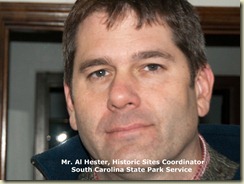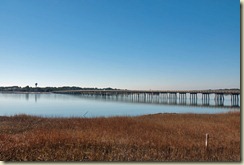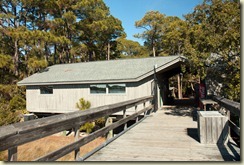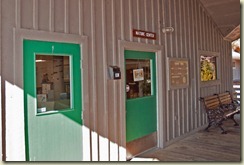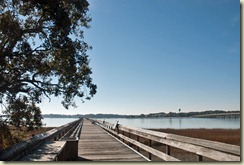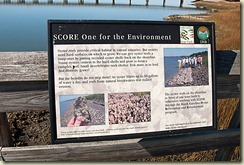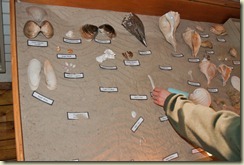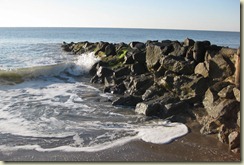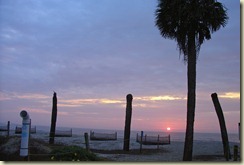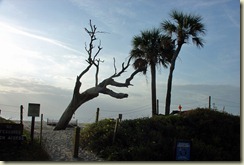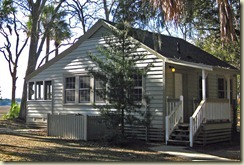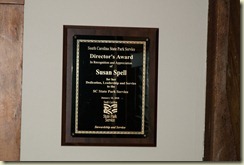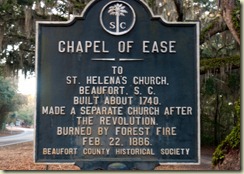 It’s near-impossible to drive more than ten miles along a South Carolina road without seeing something to write about. Well, the high-speed, homogenized interstates may be an exception. But even they have their moments.
It’s near-impossible to drive more than ten miles along a South Carolina road without seeing something to write about. Well, the high-speed, homogenized interstates may be an exception. But even they have their moments.
[As always, click any of these photos or videos for a larger view.]
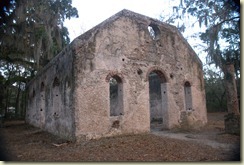 While camping last week at Hunting Island, I decided to pay a long-delayed visit to nearby Fort Fremont. It’s not far. Out Route 21 to the Frogmore intersection, left on Martin Luther King Jr. drive, and down Lands End Road for a while. Even the names of communities and roads around here enrich the scene! “Frogmore”? “Lands End Road”? I mean!
While camping last week at Hunting Island, I decided to pay a long-delayed visit to nearby Fort Fremont. It’s not far. Out Route 21 to the Frogmore intersection, left on Martin Luther King Jr. drive, and down Lands End Road for a while. Even the names of communities and roads around here enrich the scene! “Frogmore”? “Lands End Road”? I mean!
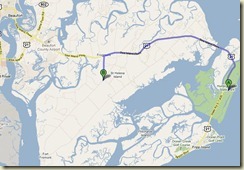 It was well into afternoon by the time I’d finished lunch and got started. And I wanted to reach Fort Fremont while there was still enough light to take a few photos. No time to dawdle along the way!
It was well into afternoon by the time I’d finished lunch and got started. And I wanted to reach Fort Fremont while there was still enough light to take a few photos. No time to dawdle along the way!
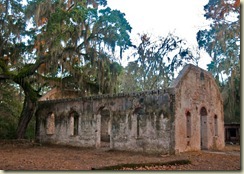 But a few miles down Lands End Road, what should appear on the left-hand side but this site. The ruins of the St. Helena’s Chapel of Ease. Just look at this!
But a few miles down Lands End Road, what should appear on the left-hand side but this site. The ruins of the St. Helena’s Chapel of Ease. Just look at this!
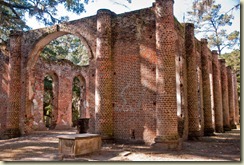 You may recall our visit a few weeks back to the Old Sheldon Church ruins. Well, this Chapel of Ease brings Old Sheldon Church to mind. But it turned out to be quite a different place.
You may recall our visit a few weeks back to the Old Sheldon Church ruins. Well, this Chapel of Ease brings Old Sheldon Church to mind. But it turned out to be quite a different place.
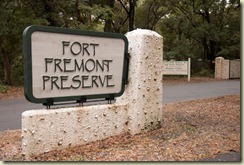 With at least a few photos of the Fort Fremont site in mind, I resisted temptation to stop for a closer look. On down Land’s End Road I drove, to the recently renovated Fort Fremont site and its impressive parking lot.
With at least a few photos of the Fort Fremont site in mind, I resisted temptation to stop for a closer look. On down Land’s End Road I drove, to the recently renovated Fort Fremont site and its impressive parking lot.
 Now, the Fort Fremont site takes some time to see. Lots there of interest. So all too soon the light began to fade, and I had to pack up camera gear and head for a grilled steak dinner at the Aliner parked on Hunting Island’s beach. Driving back, of course, along Lands End Road.
Now, the Fort Fremont site takes some time to see. Lots there of interest. So all too soon the light began to fade, and I had to pack up camera gear and head for a grilled steak dinner at the Aliner parked on Hunting Island’s beach. Driving back, of course, along Lands End Road.
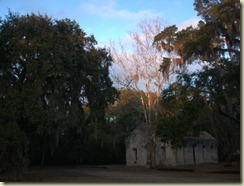 Well, there it was again. Soft dusk light, with sunshine now only in the tops of taller trees. Surrounded by lower live oaks that had the look of having seen it all. An inviting parking lot well off the road. The walls of the chapel, gleaming pale white in the dusk light. Who could resist stopping for at least a quick look around!
Well, there it was again. Soft dusk light, with sunshine now only in the tops of taller trees. Surrounded by lower live oaks that had the look of having seen it all. An inviting parking lot well off the road. The walls of the chapel, gleaming pale white in the dusk light. Who could resist stopping for at least a quick look around!
So, that’s just what I did. Pulled in to park and took a few photos and video clips as dusk turned to dark. Have a look at this interesting site:
The grounds also include a 19th century cemetery, with an interesting crypt:
There’s a story behind that partially finished brickwork. But not one I could verify, so you’ll have to find it for yourself.
When you plan your visit to the Fort Fremont site on St Helena Island, be sure to save time to stop at the Chapel of Ease as well. Another example of the interesting places the South Carolina visitor can explore.
Click here to return to the CarolinaConsidered Project website.
